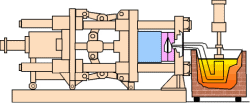Zinc parts die casting is an ingenious method of producing various engineered parts by forcing molten metal via high pressure into steel dies that can be made to be reusable under all circumstance. Such die casting molds are referred to as “dies”, and can be designed to generate complex shapes with extreme accuracy and repeatability. The end parts can be defined clearly; complete with textured or smooth surfaces suitable for a variety of uses and serviceable finishes.
Zinc castings, particularly with zinc metals are undeniably among the mass-produced items produced by the metal works industry with the highest volume, and are ever present in everyday industrial, consumer and commercial products. The existence of diecasting parts is a vital component in a wide array of products that can be found from the car parts themselves all the way down to small toys. Such parts can be simple in nature; it can be as basic as your ordinary sink faucet, and it can also be as complicated as those connector housings.
Among the first die-casting alloys that were made available to various industries were those various alloys of lead and tin. The introduction of zinc alloys, and including that of aluminum back in 1914 modified things and added better features to the viability of diecasting process. The original die cast process has matured to great lengths, from the low-pressure injection method and into techniques characterized by high-pressure casting. Modern processes now a days are fully capable of producing high integrity in die-cast parts that approximates net-shaped diecasting and surface finishes.
Alloys of Zinc are known to be the easiest metal to diecast among the materials used in die-casting. DieCastingZinc parts die casting has produced a vast number of applications available in so many commercial industries these days. The strength and the hardness element makes the zinc metal a great alternative when machining, stamping, pressing and fabricating various items used by consumers in their everyday activities. Here are some zinc metal characteristics worth noting:
Design engineers nowadays rely on zinc die casting for their component parts mainly because of the manufacturing process that combine precision and affordability. There are great considerations why zinc die-casting is much preferable over other commercial methods (plastic stampings, moldings, etc). When it comes to plastic moldings, www.diecastingzinc.com zinc diecasting presents better stability with its output that makes for stronger parts and tolerances. Zinc diecasting parts also have a better resistance regarding temperature extremes. The same can be said if it would be compared with sand casting, forging and permanent mold casting procedures.
There are also some issues with zinc parts die casting compared to screw machine products. What makes zinc die casting parts prevail is the method’s ability to make shapes otherwise difficult or even impossible with the bar or the tubular stock and keep the given tolerances without having to resort to tooling changes.
Die Casting Zinc is a Zinc Die Casting Company that manufactures zinc die casting parts. Look at this website page for more details: www.diecastingzinc.com/zinc_parts.html. Contact us at 800-524-8083 or email us at sales@diecastingzinc.com


